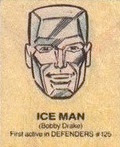Dedicated to the definitive superhero non-team.
Thursday, December 30, 2021
Man from Atlantis
Friday, December 17, 2021
Archetypes
Saturday, December 11, 2021
Wedding Bells
Friday, December 3, 2021
Space Invaders
Unlike the other exploits featuring Dr. Droom, a story published in Amazing Adventures #4 (Sept. 1961) was not reprinted a decade later when the character was reintroduced as Dr. Druid. That tale's title ominously asked, "What Lurks Within?"
When a spacecraft resembling a jack-o'-lantern landed on Earth, Dr. Droom used his telepathy to intimidate the extraterrestrials into leaving by convincing them that Earthlings were cranes with wrecking balls.
- Dr. Droom: They were our first invaders from outer space. But we defeated them by our wits! As long as we use the brains which destiny gave us, we will always be able to meet threats to our survival--no matter where they come from--or how strong the enemy may be!
That sentiment might have confused readers who had been following the adventures of Dr. Droom, as this was not his first encounter with extraterrestrials. Dr. Droom had previously thwarted the conniving Zemu from the planet Saturn in Amazing Adventures #3 (Aug. 1961).
When that story reprinted in Weird Wonder Tales #20 (Jan. 1977), Dr. Droom became Dr. Druid, Zemu became Zamu, and Saturn became the planet R'Zahn.Friday, November 26, 2021
Defenders: Tier D
Thursday, November 25, 2021
Defenders: Tier C
These images of the Defenders come from editions of The Official Handbook of the Marvel Universe.
Sunday, November 21, 2021
In the Shadow of Tier S
Tuesday, November 16, 2021
Defenders: Tier B
Saturday, November 13, 2021
Defenders: Tier A
Sunday, October 24, 2021
The Competitiveness of Captain Ultra
Tuesday, October 19, 2021
Reading with White Tiger
Friday, October 15, 2021
The Avenging Angel
Friday, October 8, 2021
Variant
Friday, October 1, 2021
Return of the Nautilus!
Friday, September 24, 2021
A Question of Canon
Thursday, September 16, 2021
Cat and Mouse
Tuesday, September 14, 2021
Defenders Dialogue: Built by Yandroth
The letters page in Defenders #8 addressed a discrepancy between dialogue from the non-team's first mission and the panel below from issue #5. Acknowledging the inconsistency, the editorial staff awarded one reader with a sought-after no-prize.
- Marvel Madmen,
- According to DEFENDERS #5, we should not be here now. Observe. Page 18, panel 1: the Omegatron says "I am the Omegatron, built by Yandroth, scientist supreme, to atomically disintegrate this planet." Notice, he said his creator's name. Check.
- In MARVEL FEATURE #1, it was explained that when the Omegatron said his maker's name, the world would explode. He said it and the world is still here.
- I claim a no-prize.
- Also, leave Valkyrie in the DEFENDERS. She would make a good member. I'm glad the Hulk left. Please, Steve, let's keep it that way.
- RFO, KOF, FFF Christopher Coleman
Fitchburg, Mass.
- Chris, we tried hard to think of a way out of this one, hoping all the while that what Yandroth meant was that his machine would bring doom when it said his name at the correct time—but a quick check of MARVEL FEATURE #1 shows him mumbling "…once, and only once, it shall speak my name…", so we're caught like rats in a trap. You win true believer; the no-prize is yours, right after Roy gets through beating up Steve with it.
Sunday, September 12, 2021
Weird Wonder Tales
Wednesday, September 8, 2021
A Gift for Galactus
Tuesday, September 7, 2021
The Squadron Symmetry
Monday, August 30, 2021
Dr. Druid and the Missing Link
Tuesday, August 17, 2021
Reversal
Tuesday, July 27, 2021
I, Robot
Sunday, July 25, 2021
Blast from the Past
Friday, July 23, 2021
Strange Tales with Bobby Drake
Saturday, July 10, 2021
Nighthawk's Rogues
Friday, July 9, 2021
The Making of Marvel Man
Monday, July 5, 2021
Adapting Alice
|









































































